|
|
||
|
||
|
|||
| Quantum of Solace review by Graham Rye |
Warning: Contains major spoilers! |
||
|
Casino Royale was arguably the greatest Ian Fleming James Bond film since 1969’s On Her Majesty’s Secret Service. It had a good solid story based on Fleming’s 1953 novel with a clear narrative structure and a cohesive plot, interesting characters, a listenable music score, the right amount of action, and heart; and an impressively commanding central performance from its new Bond, Daniel Craig. Mostly all these elements are sadly missing from Quantum of Solace, making this 22nd Bond film barren of entertainment and sterile as the desert in which its climax (of sorts) takes place. In the Bourne films trilogy Jason Bourne is a seemingly soulless killer without identity, and in this latest 007 adventure James Bond has become his physically invulnerable ‘twin’. |
|||
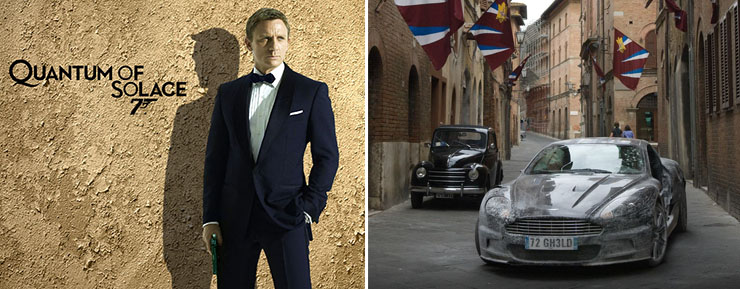 |
|||
|
I get no joy from writing such a negative review of a creative work in a
series of films I have come to love as I would a treasured family member,
but it has to be said that the twenty second Bond film, Quantum of
Solace is a major disappointment after the excellence of its prequel.
On a technical level Quantum is mostly a tour de force, but as an
engaging piece of cinema entertainment I’m afraid it falls considerably
short of the benchmark set by 2006’s Casino Royale. |
|||
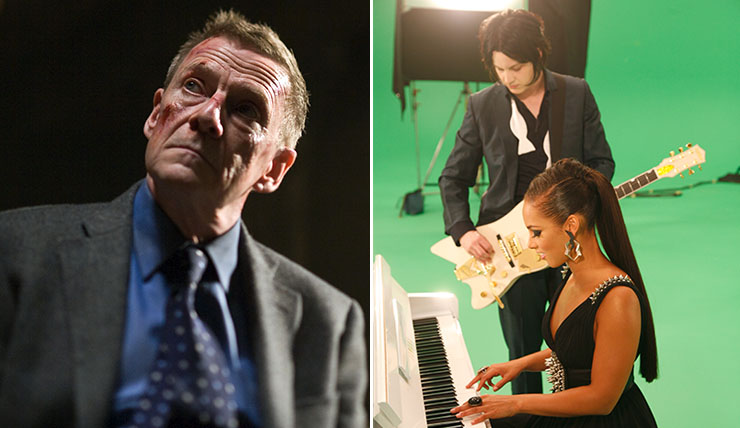 |
|||
|
The film opens with a VERY LOUD nerve-shredding car chase that is so bone-crunchingly
realised it’s actually like being in a car crash! This opening chase has a
dénouement that immediately connects Quantum to Casino Royale
when Bond opens the boot of his battle scarred Aston Martin to reveal he’s
been carrying a passenger, the painfully wounded Mr White (Jesper
Christensen), who 007 shot at his Bond, James Bond moment at the ending of
Casino Royale – segue into the lacklustre and instantly forgettable
credit titles produced by MK12. Daniel Kleinman’s contribution to the Bond
films since 1995 should never be underestimated, and here his design eye
is sorely missed in spades. Jack White’s distorted guitar and Alicia Key’s
painful wailing over the credit titles does nothing to ease an audience
into the feeling they are about to experience a ‘Bond film’. I suspect
that Bond filmmakers EON Productions could do little but grit their teeth
collectively and smile when they had this title track hoisted upon them by
some wunderkind at SONY. ‘Another Way To Die’ sounds more like a bad demo
for a Bond title song, but one that has ticked all the boxes for the
studios’ marketing demographics. |
|||
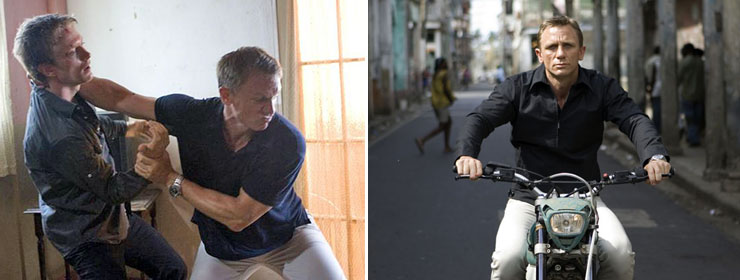 |
|||
|
Exiting the hitman’s hotel with the killer’s steel briefcase in his hand,
Bond is ordered to get into a car driven by an attractive young woman,
Camille (Olga Kurylenko). Why? As they’ve never met before, who does she
think he is? As they drive Bond notices in the rear mirror they are being
followed by a black Haitian man on a motorbike. This whole sequence is
confusing and fails to impart any relevance of what’s actually taking
place, and isn’t helped at all by the dialogue: The case open on his lap reveals a handgun and a photograph identifying Camille as the hitman’s target. She pulls a gun on Bond but quick as a flash he grabs her wrist as the gun goes off harmlessly out of the open car window. Bond exits the car in a hurry and then ‘relieves’ the man who’s been shadowing them of his motorbike in two quick clean moves – probably his coolest move in the whole picture! We later understand (I think) that Camille, believing Bond to be the dead man, has collected him at the request of her lover, Dominic Green (Mathieu Amalric), who has hired the man to kill her (?) because of her duplicity in attempting to buy secret information from one of his best geologists. It appears that in a foolhardy double bluff Camille has returned to her ‘lover’ Greene even after knowing he has tried to have her killed, but still unaware of the actual identity of her passenger. However, Greene isn’t convinced by Camille’s bluff, and after showing her the dead geologist floating in the sea under the jetty on which they’re standing, he hands her over to his business associate and Bolivian dictator-in-waiting, the repellent General Medrano (Joaquín Cosio), who we later discover years earlier has killed her father and also raped and murdered her mother and sister, leaving Camille, a little child, to burn to death in the family home. Green suggests to Medrano in no uncertain terms he should kill Camille once he’s had his ‘fun’ with her and throw her body overboard. Meanwhile, Bond has been observing this interaction from a distance on the motorbike outside the fenced area surrounding the jetty. Seeing the girl being taken away by Medrano and his heavily armed guards Bond races into action on the motorbike and into the film’s boat chase. Why Bond should have set out to rescue Camille after spending less than three minutes with her in her car, and being shot at by her, is anyone’s guess, but hey – he’s the hero, heroes do that sort of crazy thing, and besides, Ian Fleming’s Bond was always partial to a bird with its wing down! But it makes little real sense. Camille is knocked unconscious during the frenetic boat chase and landing on the far jetty Bond dumps her in the arms of a startled boat boy, quipping, “She's sea sick!” |
|||
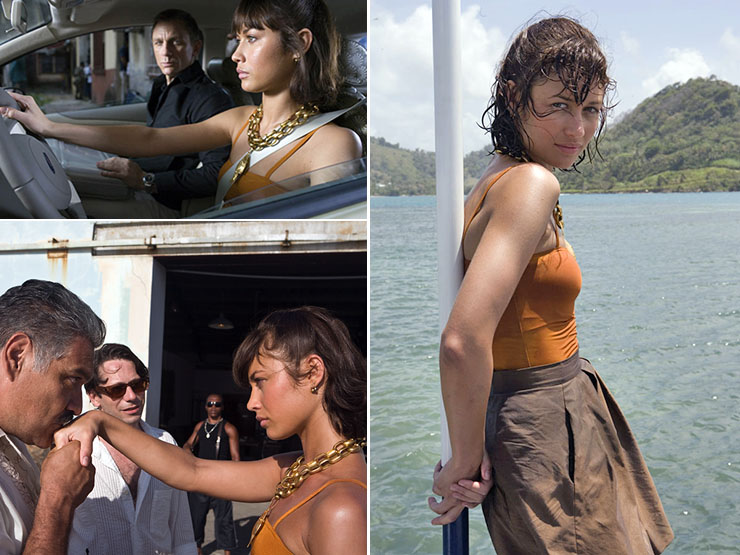 |
|||
|
The action next moves to Bregenz, Austria, where a production of Puccini’s opera ‘Tosca’ is taking place on the world famous floating stage on Lake Constance. The opera performance is in modern dress, and back stage Bond conveniently finds a Tom Ford tuxedo to fit his measurements, leaving a muscular opera performer wondering how he’s going to appear on stage wearing only his underpants! Blending in and mingling with the many upmarket guests arriving for the opera Bond notices that certain ‘special’ guests on a checklist are being given a different goodie bag the receptionist produces from under a table. Following one of these ‘special’ guests into the gent’s restroom Bond ‘relieves’ him of the bag, which on inspection contains an earpiece receiver and microphone. Now wearing the earpiece, Bond secretes himself in the scaffolding high up in the set on the floating stage where he spies on Dominic Greene and the audience far below. It soon becomes clear via his earpiece that Greene is using the event to camouflage a ‘board meeting’ of members of Quantum, the mysterious organisation in which we assume Greene is a high-ranking member. After listening-in to Greene’s conversation with the secret assembly, Bond interrupts with: “Can I offer an opinion. I really think you people should find a better place to meet!” and creates exactly the response he wants as some of the Quantum members panic and immediately leave their seats, enabling him to quickly snatch shots of them on his SONY mobile phone and patch them through to M for identification. Only the cool-as-a-cucumber Mr White stays seated in the audience and remains undetected by Bond. With their plan to hide in plain sight backfiring and their anonymity compromised, Greene orders everyone to disperse and remove any evidence of them being there. On the way out of the opera house Greene and his henchmen run into Bond on one of the landings. Outnumbered, Bond attempts to make a fast exit, only to end up in a running gun battle that spills over into the opera house restaurant full of diners in evening dress [why aren’t they watching the opera?]. This could have been an exceptionally thrilling and nail-biting sequence, but in the hands of director Marc Forster I’m afraid it becomes something more at home in an art house movie as Bond’s gun battle with Greene’s goons in slow-motion is intercut simultaneously with the mock violence of guns being fired and actors falling dead in the performance of ‘Tosca’, bringing to mind the far superior climax of Francis Ford Coppola’s Godfather Part III. And as Bond leaves the opera house he takes out another attacker who he believes to be one of Greene’s men in the same style as Roger Moore’s 007 did to Stromberg’s henchman Sandor in The Spy Who Loved Me. Quantum of Solace is curiously littered with in-jokes to past Bond films that can’t possibly mean anything to a casual audience member and are mostly distracting to those whom it does! It’s an idea that should have died with Die Another Day. |
|||
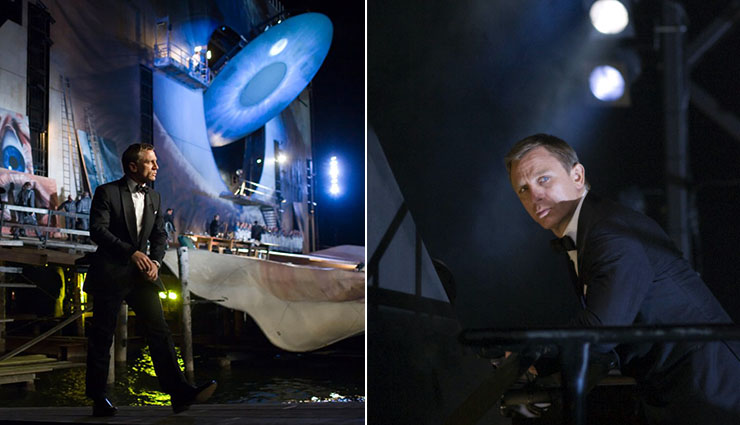 |
|||
|
Finding his credit cards have been cancelled by M, Bond visits the only
person he believes he can trust – Mathis (Giancarlo Giannini). Why? After
believing that Mathis was on Le Chiffre’s payroll and having him viciously
interrogated and tortured at the end of Casino Royale, how did MI6
and Bond discover and prove to themselves he was completely innocent? A
throwaway line that he’s been given his villa in Italy as compensation for
the security services mistake hardly explains why Mathis is Bond’s new
best friend! Inexplicably, Bond wants Mathis to accompany him to Bolivia,
where Greene’s master plan is to take effect. Why? Only after he asks him
does Mathis explain to Bond that he had spent seven years in the country,
or did Bond already have that information? It’s a very contrived way of
getting the character of Mathis to Bolivia. Why would Mathis want to go
anywhere with Bond after his experience at the hands of MI6? |
|||
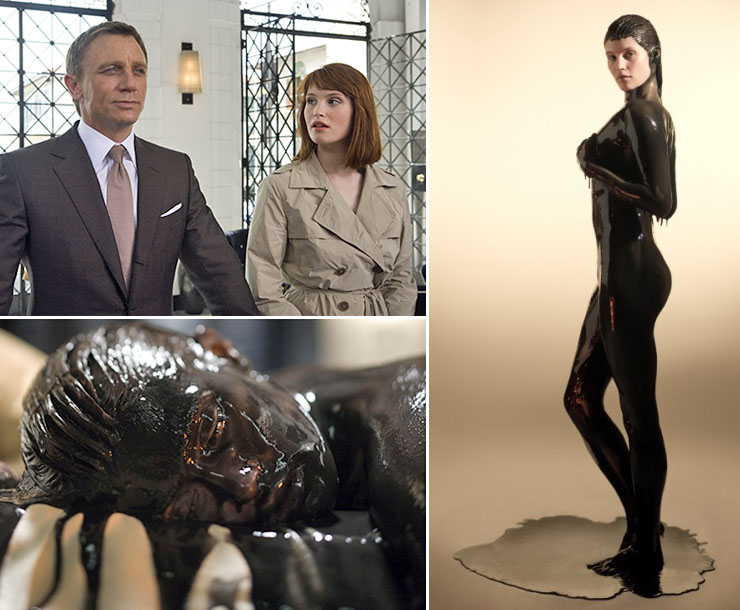 |
|||
|
When Agent Fields takes Bond and Mathis to stay at a seedy Bolivian hotel
under their cover as teachers on a sabbatical, Bond baulks at the
potentially cockroach infested joint, “I’d rather stay in a morgue!” he
exclaims and takes them all to the best hotel in town, allowing Bond the
funniest one-liner in the whole picture as he announces to the reception
staff: “We’re teachers on a sabbatical – who won the Lottery!” Very funny,
but more Roger Moore than Daniel Craig, and out of step with the rest of
the film. |
|||
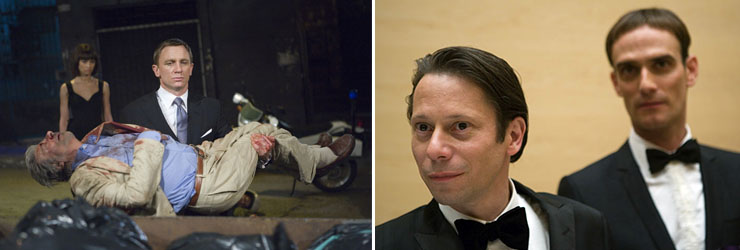 |
|||
|
Returning to the hotel with Camille, where he’s been staying with Fields
and Mathis, Bond discovers his ‘wife’ has left a message for him at the
front desk. All it says is, “Run.” Considering her fate, when exactly
would she have found time to leave this message? Alarmed by Field’s
message Bond asks Camille to stay in the lobby while he checks upstairs.
Discovering the door to his room open he enters to find M, accompanied by
a number of armed burly MI6 security officers. Believing he is on a
violent revenge fuelled rampage and responsible for the deaths of not only
the two Bolivian policemen but also Mathis, M demands 007 hand over his
weapon and revokes his licence to kill, but not before she reveals to him
the naked dead body of Fields on his hotel bed. The girl has been drowned
in crude oil and is covered from head to toe in the black gold. |
|||
 |
|||
|
Having no interest in Camille, M orders her men to let her go. Then orders
her armed guards to escort Bond from the hotel and back to the UK under
close arrest. Bond waits until he enters the elevator with the four guards
before he explodes into action knocking all of them out cold. Making his
way back through the hotel by running on the outside ledge of the interior
balcony, leaping over the banister he bumps into M on the way out and
quickly explains to her he didn’t kill Mathis. Outside the hotel, Camille,
in a beaten up VW Beetle, shouts for Bond to get into her car. M orders
her men to stand down and let Bond follow his lead. During a stop-off Bond
steals a new more powerful car and he and Camille drive to an airstrip
where Bond exchanges the vehicle with an old man for an ancient
twin-propped transport plane he pilots to get him closer to Greene’s base
located in the Bolivian desert. No sooner than Bond and Camille are in the
air than the old man is on the phone, and you just know he’s not ordering
a pizza! |
|||
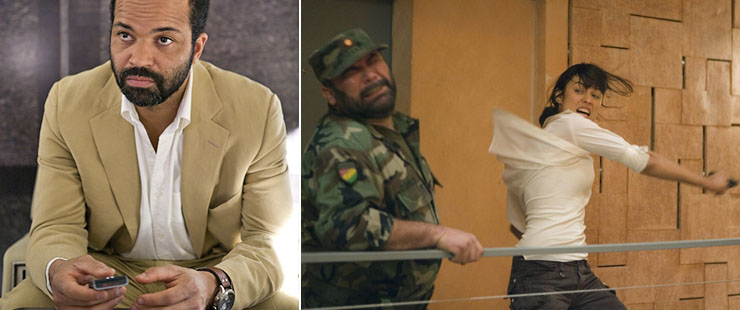 |
|||
|
After leaving the sinkhole and walking through the desert, Bond and
Camille eventually ready themselves for their assault on Greene’s base, a
hotel-like complex in the desert, and where we discover that Camille is a
rogue Bolivian agent with no kills. Somewhere in all this subterfuge,
double-cross and double-dealing is the lugubrious Felix Leiter (Jeffrey
Wright), who makes a couple of appearances for little reason other than to
show us that the CIA are often ‘in bed’ with bad people and have to work
and drink in crummy Third-World dives. Quelle surprise! Once, the casting
of an African-American in the role of Fleming’s Caucasian-written
character Felix Leiter would have caused raised eyebrows, as the literary
copyright holders opined at the news in 1983 of African-American actor
Bernie Casey being cast as the character in Never Say Never Again.
Thankfully in 2008 no one gives a hoot! |
|||
 |
|||
|
Daniel Craig (or Creg as the American TV networks insist on calling him)
is once again a commanding figure but given little chance to shine with
the material on view here. Had he at the end of the picture looked into
the camera and uttered the line, “I’ll be back!” it would have come as no
surprise after watching his Terminator-like performance as little more
than a cold killing machine. The smart dialogue and interplay between
characters that was such an attractive feature of Casino Royale is
barely on display here. Screenwriters Paul Haggis, Neal Purvis, and Robert
Wade having made such a perfect job of Craig’s first 007 outing have
seriously lost the plot here! We can only guess how deadlines and various
re-writes during production may have affected their original intentions. |
|||
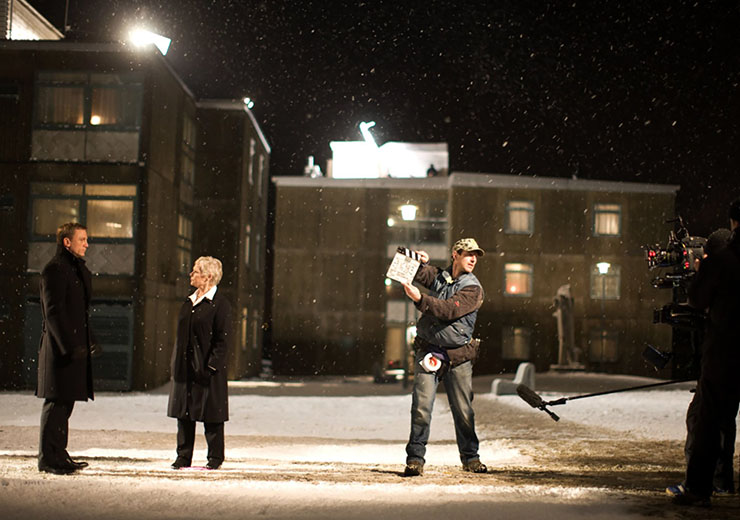 |
|||
|
David Arnold’s musical score for Quantum, if you can call it that,
is once again little more than a cacophony of noise from the Die
Another Day School of tub-thumping musak. More like a stampede of
musical notes rather than purposely placed crotchets and quavers on a
score sheet by a composer who actually knows how to compose a melody. And
where was the integral sound of The James Bond Theme when we needed it? I’ve
heard enough – next composer please! |
|||